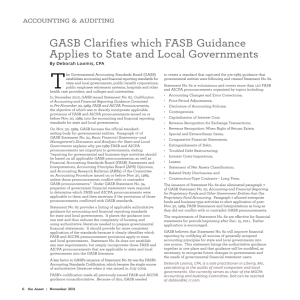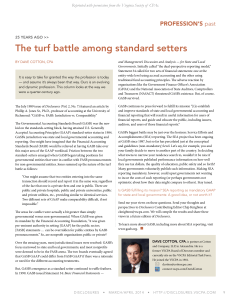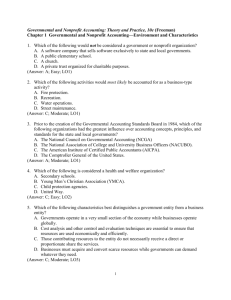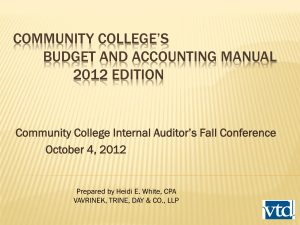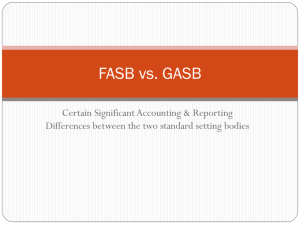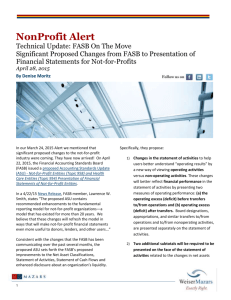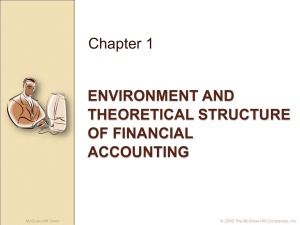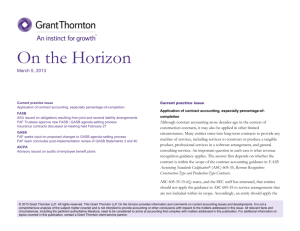GASB or FASB? Making the Right Decision for
advertisement
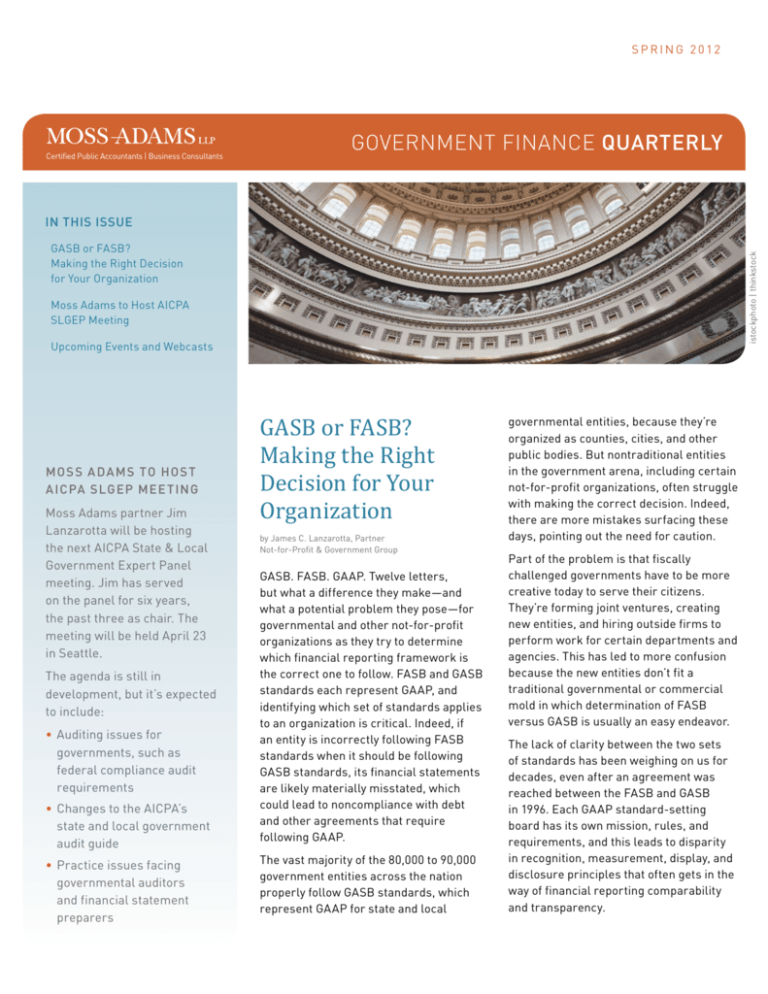
spring 2 0 1 2 Certified Public Accountants | Business Consultants government finance Quarterly In this issue istockphoto | thinkstock GASB or FASB? Making the Right Decision for Your Organization Moss Adams to Host AICPA SLGEP Meeting Upcoming Events and Webcasts Mos s A dam s to Hos t A ICPA SLGEP Mee t ing Moss Adams partner Jim Lanzarotta will be hosting the next AICPA State & Local Government Expert Panel meeting. Jim has served on the panel for six years, the past three as chair. The meeting will be held April 23 in Seattle. The agenda is still in development, but it’s expected to include: • Auditing issues for governments, such as federal compliance audit requirements • Changes to the AICPA’s state and local government audit guide • Practice issues facing governmental auditors and financial statement preparers GASB or FASB? Making the Right Decision for Your Organization by James C. Lanzarotta, Partner Not-for-Profit & Government Group GASB. FASB. GAAP. Twelve letters, but what a difference they make—and what a potential problem they pose—for governmental and other not-for-profit organizations as they try to determine which financial reporting framework is the correct one to follow. FASB and GASB standards each represent GAAP, and identifying which set of standards applies to an organization is critical. Indeed, if an entity is incorrectly following FASB standards when it should be following GASB standards, its financial statements are likely materially misstated, which could lead to noncompliance with debt and other agreements that require following GAAP. The vast majority of the 80,000 to 90,000 government entities across the nation properly follow GASB standards, which represent GAAP for state and local governmental entities, because they’re organized as counties, cities, and other public bodies. But nontraditional entities in the government arena, including certain not-for-profit organizations, often struggle with making the correct decision. Indeed, there are more mistakes surfacing these days, pointing out the need for caution. Part of the problem is that fiscally challenged governments have to be more creative today to serve their citizens. They’re forming joint ventures, creating new entities, and hiring outside firms to perform work for certain departments and agencies. This has led to more confusion because the new entities don’t fit a traditional governmental or commercial mold in which determination of FASB versus GASB is usually an easy endeavor. The lack of clarity between the two sets of standards has been weighing on us for decades, even after an agreement was reached between the FASB and GASB in 1996. Each GAAP standard-setting board has its own mission, rules, and requirements, and this leads to disparity in recognition, measurement, display, and disclosure principles that often gets in the way of financial reporting comparability and transparency. Upc oming E v ent s a nd W ebca s t s Oregon Municipal Finance Officers Association Spring Conference March 4–7 | Bend, OR Join Moss Adams partner Jim Lanzarotta as he presents on the status and impact of developments and proposals from the GASB, SEC, GAO, and others. He’ll also walk through the GASB exposure draft on the accounting and reporting of public pension plans. Learn more about this and other upcoming events. Government Accounting, Auditing, and Regulatory Update May 10 | Online Join our annual review highlighting recent developments and new audit and accounting requirements affecting state and local governments this year. We’ll also preview proposed changes. Learn more about this and other upcoming webcasts. GOVERNMENT FINANCE QUARTERLY The contrast between the GASB and FASB is especially striking when it comes to the nature, form, and format of the required financial statements; the accounting for certain events or transactions, such as investments and employee benefit programs; and required footnote disclosures. In a nutshell the FASB wants to help investors and creditors make financial decisions. The GASB, on the other hand, is about accountability, because governments use taxpayer funds. That said, both boards try to take each other’s perspective into account when setting standards, although they’re reluctant to put more definitive guidance for determining whether to follow FASB or GASB standards into their own standards or codifications. The American Institute of Certified Public Accountants’ (AICPA) government and not-for-profit audit and accounting guides provide the most comprehensive guidance currently available about the applicability of FASB and GASB standards. Unfortunately, the AICPA guides aren’t incorporated at the highest level of GAAP. Furthermore, the GASB and FASB define the AICPA guides at different levels of GAAP—Level B GAAP under GASB and “other accounting literature” under FASB—compounding the confusion. All this complexity surrounding GASB and FASB standards is forcing organizations and their financial consultants to work harder to avoid costly mistakes. The first—and most crucial—issue to determine is the level of involvement and control a governmental entity has over an organizational structure, net assets, and operations. The agreement between the FASB and GASB, as provided for in the Jupiterimages | thinkstock moss adams | S P R I N G 2 0 1 2 AICPA guides, is that, generally speaking, an organization should use GASB standards if: • It’s a state, city, town, or municipality created for the administration of public affairs • Its officers are popularly elected • The majority of its governing body is appointed by another governmental entity • Its assets go to a government if the organization is dissolved • It has the power to enact or enforce a tax levy It’s the ability of a government to appoint or control a majority of the separate entity’s board and to dissolve the entity, with its net assets reverting to the government, that tends to be the key provision requiring GASB reporting. Another key issue involves employee benefit plans. Here the confusion stems from the fact that many of the federal ERISA (Employee Retirement Income page 2 GOVERNMENT FINANCE QUARTERLY moss adams | S P R I N G 2 0 1 2 plans sponsored or administered by a governmental entity. iStock | thinkstock In our experience, entities created to provide services to governments—such as chartered not-for-profit organizations, auxiliaries and foundations supporting public colleges and universities, business activities of Indian tribes such as casinos, and governmental pension plans subject to ERISA—are often where reporting mistakes are made. Security Act of 1974) requirements and disclosures for corporate pensions, codified through FASB standards, simply aren’t applicable to state and local government plans. As a result, when ERISA does apply, organizations often report their plans using FASB standards, which isn’t appropriate for The bottom line is that nontraditional entities in the government arena, including certain not-for-profit organizations— indeed, any organization that isn’t a typical commercial enterprise—must review the guidance and make sure it understands whether GASB or FASB standards apply. The decision itself isn’t often a difficult one. In fact, once an analysis is performed of the underlying rules, the correct reporting framework is often black-and-white. The challenge for most organizations is simply being aware of the issue in the first place. A bou t Mos s A dam s Across the nation, Moss Adams LLP provides insight and expertise to public, private, and notfor-profit enterprises in a wide range of industries. To discover how we can make a difference to your organization, visit www.mossadams.com. Acumen. Agility. Answers. The material appearing in this communication is for informational purposes only and should not be construed as legal, accounting, or tax advice or opinion provided by Moss Adams LLP. This information is not intended to create, and receipt does not constitute, a legal relationship, including, but not limited to, an accountant-client relationship. Although these materials have been prepared by professionals, the user should not substitute these materials for professional services and should seek advice from an independent advisor before acting on any information presented. Moss Adams LLP assumes no obligation to provide notification of changes in tax laws or other factors that could affect the information provided. page 3

